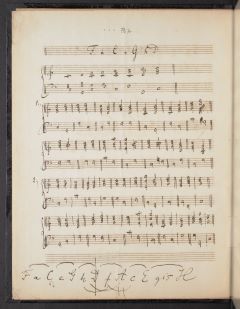What an anniversary year is good for
Thursday, July 11, 2024

The following text by Eberhard von Oppen originally appeared on the Carus-Blog and is reproduced here with the publisher’s kind permission.
The tendency to focus on “round” time intervals according to the globally dominant decimal system and celebrate the respective anniversaries is as widespread as it is justifiable, since the result often proves quite fascinating – be it the arithmetically coincidental combination of the most diverse “jubilarians,” or the stimulus to repeatedly take a closer look at supposedly well-known people or events – let alone a previously little or not at all known historical figure or event.
Let us take the current year 2024 as an example, the anniversaries of which range from the founding of the monastery on the island of Reichenau in 724 through Immanuel Kant’s birth (1724) and the publication of Goethe’s Werther (1774) to the liberation of Leningrad from the murderous German blockade (1944) or the coming into effect of the historic Basic Law for the Federal Republic of Germany (1949). Music lovers and also music publishers will of course be interested in another special area: the history of music. Here we have the birthdays of Bruckner and Smetana (1824) or Schönberg (1874); the anniversary of Puccini’s death (1924), as well as important dates of composition or first performances (among many others) of Schubert’s String Quartet in D minor (1824), Johann Strauss’ Fledermaus (1874), or Gershwin’s Rhapsody in Blue (1924).
Peter Cornelius, who was born in 1824 and died in 1874, has a double anniversary (as does the writer Erich Kästner, 1899–1974; Kurt Weill, who lived from 1900 to 1950, had an even more “rounded” lifetime). Cornelius undoubtedly deserves to be better known and more widely recognized than he is today. Born in Mainz in 1824 into a family of actors, his feel for language was stimulated and promoted early on: he learned French, English and Polish, as well as the piano and the violin. He studied in Berlin, where he met Bettina von Arnim, Eichendorff, Humboldt and Meyerbeer, while also writing music reviews and composing. He got to know and admire Franz Liszt and lived with him for five years as his secretary and translator in Weimar. Gifted with wit and irony, but also with great kindness, Cornelius cultivated numerous old and new acquaintances, met Hans von Bülow and the revered Hector Berlioz, while musically getting closer to the “New Germans” around Liszt and Wagner. He got to know and admire the latter, and was also acquainted with Johannes Brahms and both Clara and Robert Schumann, but retained his artistic integrity. Moving to Vienna for another five years, he stayed in frequent touch with Wagner while nonetheless distancing himself from him, and became friends with Friedrich Hebbel. In 1864, thanks to Wagner’s mediation, he accepted a “salary of grace” from Ludwig II in Munich, where, already over 40 years of age, he received a permanent position for the first time in his life as a teacher of rhetoric and composition at the newly founded conservatory. On 26 October 1874, still in his forties, Peter Cornelius died from a then untreatable diabetic condition in his hometown Mainz, which he always kept in touch with and where today not only a street and a square but also the city’s music conservatory bears his name (and which currently honors him with special exhibitions).
His dual talent as writer and musician led Cornelius not only to translating others’ libretti (such as the one for Berlioz’s oratorio L’Enfance du Christ) but also to compose operas to his own (above all the highly successful Barbier von Bagdad (RISM Catalog | RISM Online)), and to base a large number of his songs and choral works on his own texts, or in any case on rather demanding texts, all of which demonstrate his refined sense of harmony. A real gem of expressive choral writing is his six-part Requiem to Friedrich Hebbel’s words “Seele, vergiss sie nicht, Seele, vergiss nicht die Toten” (“Soul, do not forget them, Soul, do not forget the dead”); a ‘German Requiem,’ as it were (RISM ID no. 1001048891 - RISM Catalog | RISM Online). While this work, as well as the six- to eight-part Drei Chorgesänge (op. 11) to texts by Heine and Rückert, partly also the three-part choral cycle Liebe (op. 18) and the male choruses Ach, wie nichtig and Mitten wir im Leben sind (op. 9) require highly capable choirs, the appealing and relatively simple three Psalmlieder arrangements (op. 13) based on Bach’s piano settings lend themselves to amateur choirs. Besides, one should not forget about the arguably most famous work by Peter Cornelius, who was incidentally born on Christmas Eve: in the six-part song cycle (op. 8) based on his own poems with the simple title Weihnachtslieder (RISM ID no. 1001038690 - RISM Catalog | RISM Online) – a cycle that Werner Oehlmann described as “virtually the only artistically perfectly valid [work] that the music of the 19th century produced on the subject of Christmas” – the third song Drei Kön’ge wandern aus Morgenland combines a characteristically melodic solo voice with a 4-part setting of the Epiphany song “Wie schön leuchtet der Morgenstern” in the piano part. Hans Georg Pflüger transformed this piano accompaniment once again into a chorus; finally, Clytus Gottwald arranged the whole work for seven-part choir.
Will other choral works by Peter Cornelius – who also set liturgical texts to music – gain wider popularity? Whatever the future holds, the following certainly also applies to him:
Mancher Mensch und manche Zeit
zeigt bei der Gelegenheit
des Gedenkjahrs neue Seiten,
die die Horizonte weiten…
Some people and some times
show on the occasion
of the commemorative year new sides
that broaden horizons…
Image: p. 2 of Peter Cornelius’s study book from 1870/71, autograph in the Austrian National Library in Vienna, A-Wn Mus.Hs.4794 (RISM ID no. 600108768 - RISM Catalog | RISM Online). Available online.
Share Tweet EmailCatégorie: Evénements

